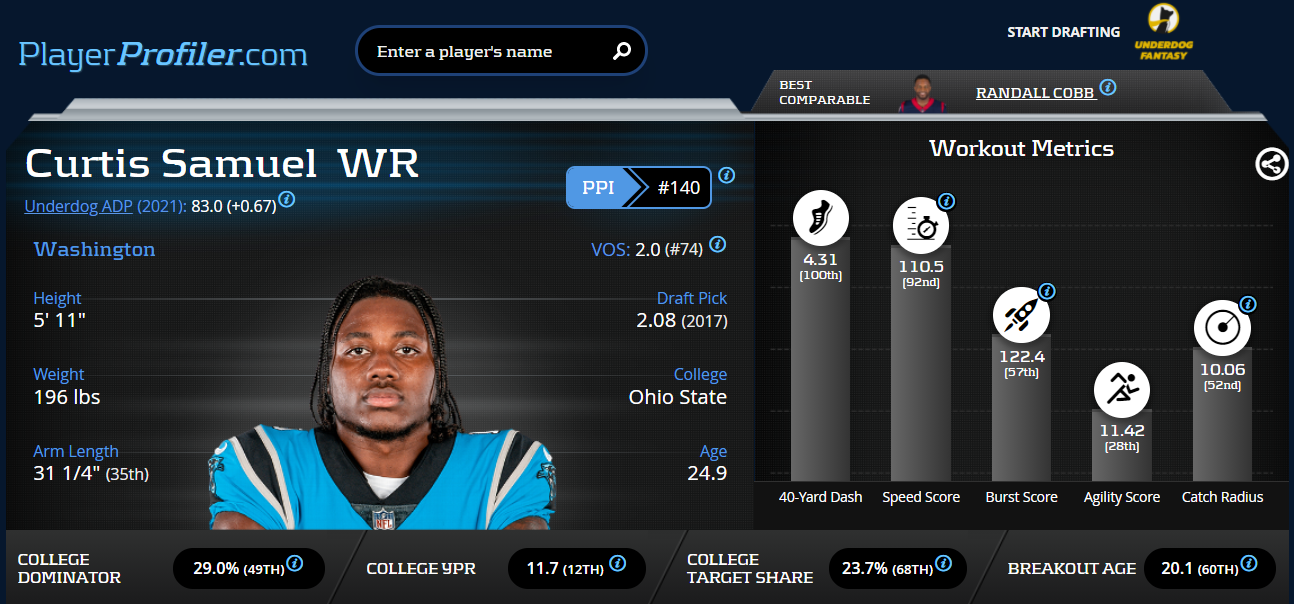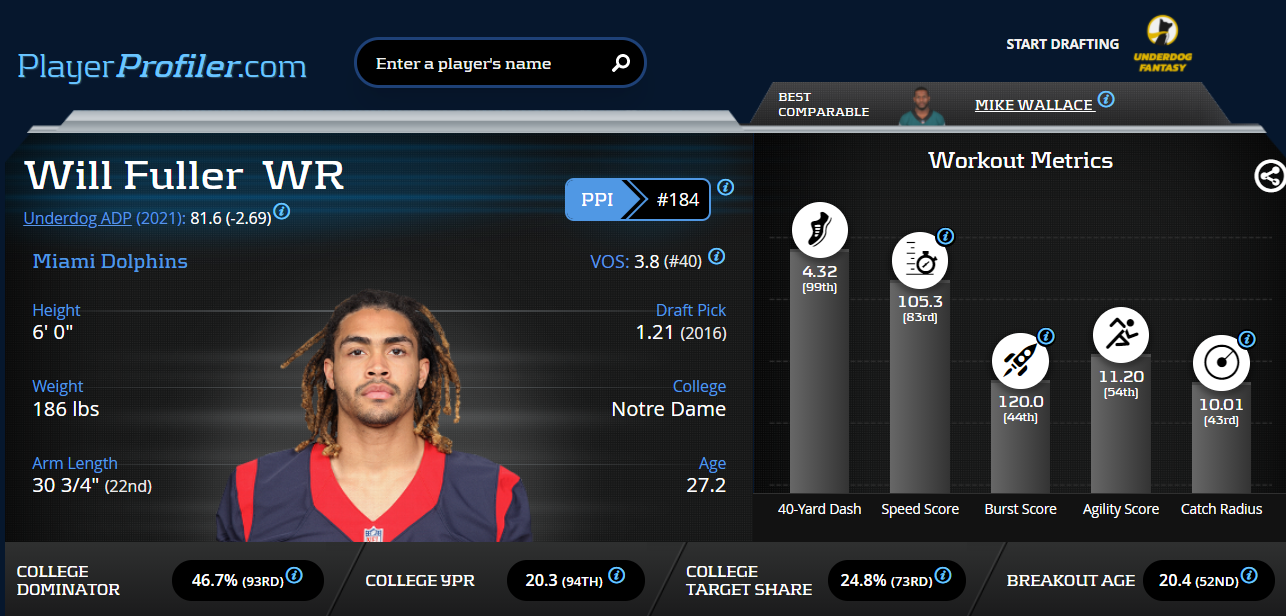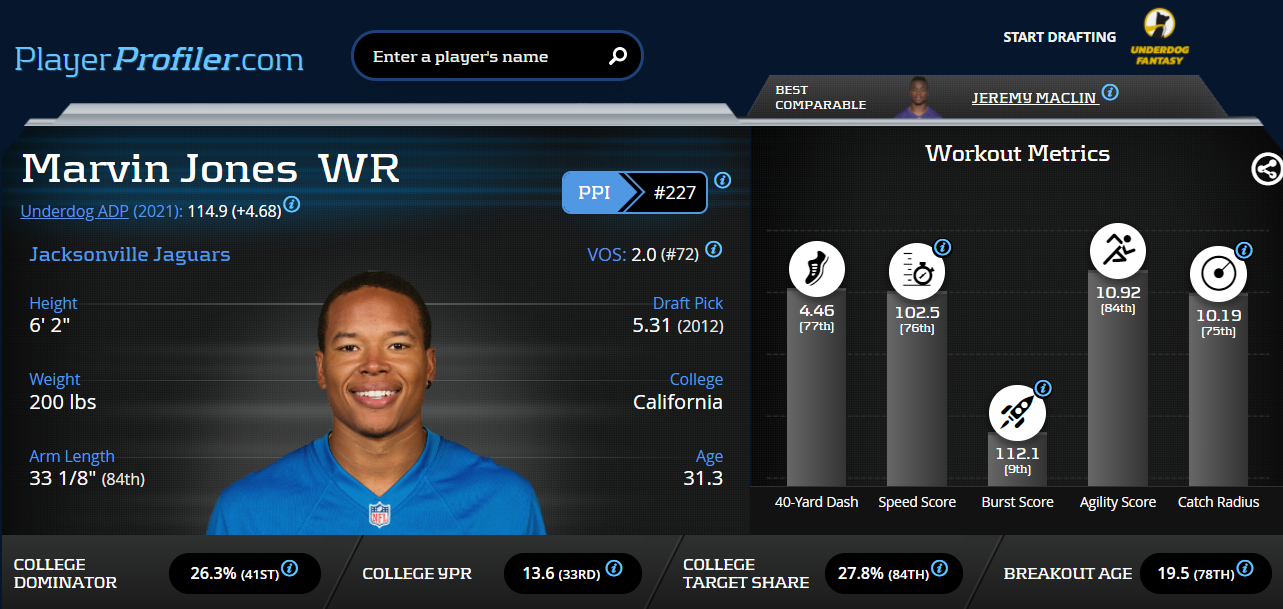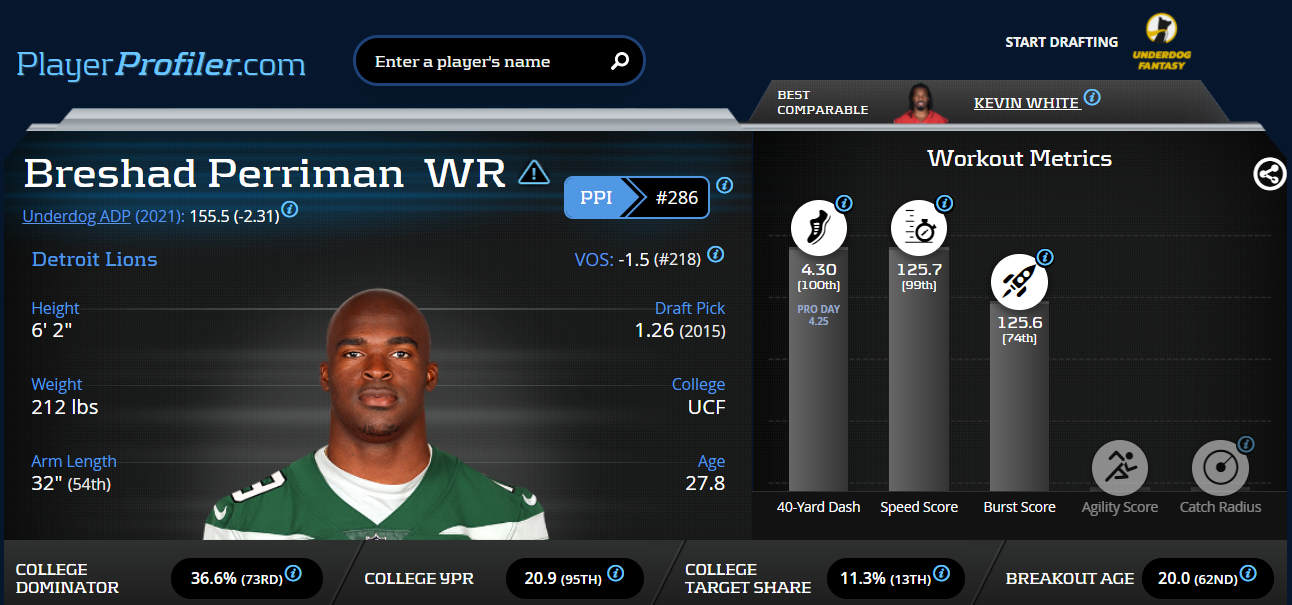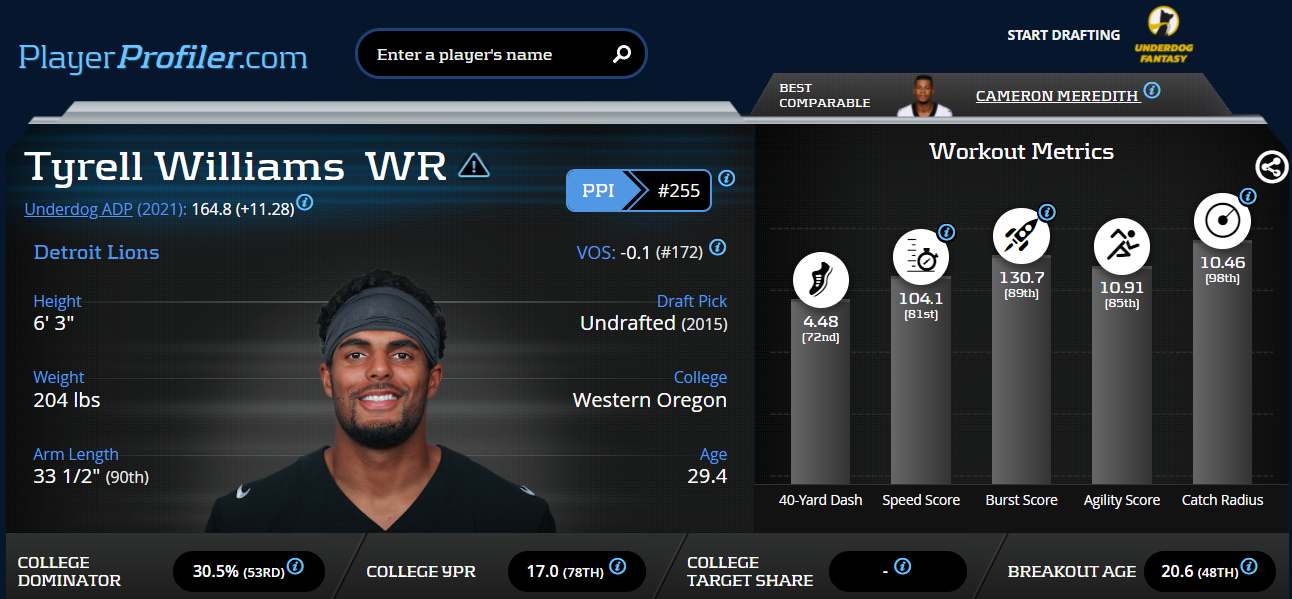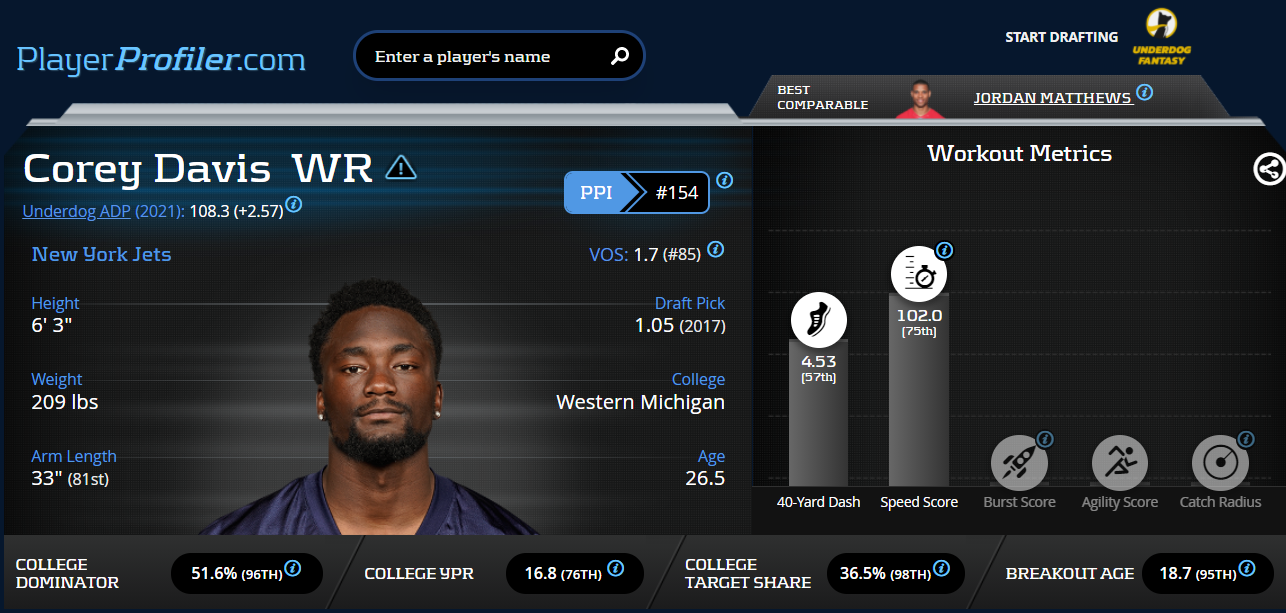Several wide receivers shifted teams ahead of the 2021 season, changing their projections and perceptions across the fantasy landscape. So, which of these players on new teams holds more value now? Which ones will bring bang for their buck and break out a tier above their ADP? Wide receiver fantasy value for players on new teams can be shown through their productivity and efficiency last season, along with their situations this season.
Target Premium and Fantasy Points Per Target can especially help with showing potential for value. PlayerProfiler defines Target Premium as “the percentage of additional fantasy points per target a receiver generates over other receivers on the team. It is useful when seeing the impact of a QB upgrade on production and is statistically highly correlated with fantasy points per target for the same season.” Both metrics, along with others, can help determine how valuable a wide receiver will be with his new team, and if he can break above his ADP.
The primary criteria we’re looking for:
- -High marks in Target Premium and/or Fantasy Points Per Target
- -QB/opportunity upgrade
- -Low Underdog ADP relative to production/efficiency provided
Over half of qualifying wideouts with positive 2019 Target Premiums saw an increase in Fantasy Points Per Game and/or targets per game in 2020. Robby Anderson is one example of a value WR that went to a new team for 2020. He had a +2.1-percent (No. 54 among qualified wide receivers) Target Premium in 2019, along with averages of 6.0 targets per game and 10.0 (No. 54) Fantasy Points Per Game. While Anderson’s Target Premium wasn’t significantly high, it was positive and he saw a small QB/offense upgrade, going from the Jets and Sam Darnold to the Panthers and Teddy Bridgewater. In 2020, with the slight upgrade, Anderson saw 8.6 targets per game, a higher Target Share, and had a 13.8 (No. 30) Fantasy Points Per Game average. Not bad for a player with an ADP in the 100s.
You won’t see Kenny Golladay here since he experienced a quarterback downgrade in going to his new team. While he could flourish fantasy-wise this season, he is being drafted in a range that suits him. He goes from Matthew Stafford to Daniel Jones and has not received a Target Share above 21.1-percent in last few seasons, showing he may not yet be on the WR1 opportunity tier.
Curtis Samuel, Football Team
Moving from Carolina to Washington, Curtis Samuel gets Ryan Fitzpatrick at QB, with a potential dash of Taylor Heinicke. In 2020, Samuel primarily caught passes from Teddy Bridgewater, seeing a 7.2 (No. 98) Average Target Distance mark. Despite this, he averaged 2.18 (No. 12) Fantasy Points Per Target with a +32.0-percent (No. 3) Target Premium. He specialized in taking low-depth targets and turning upfield, with 77 (No. 21) receptions at a 79.4-percent (No. 2) Catch Rate and 337 (No. 22) yards after catch.
With Washington, Samuel will likely see an increase in pass plays. His 2020 Panthers averaged 36.7 (No. 21) Team Pass Plays Per Game, while Washington had a 40.7 (No. 8) average. However, Fitzmagic did have a lesser Accuracy Rating than Bridgewater last season. Bridgewater’s high accuracy stemmed from his lower Air Yards Per Attempt, with many low-depth targets to Samuel, Christian McCaffrey, Mike Davis, and others. So, even though Samuel gets a small decrease in target accuracy, he gets a jump in yards per target from a better long-distance passer. Fitzpatrick even had a higher Catchable Pass Rate (80.1-percent, No. 4) than Bridgewater (78.9-percent, No. 7), despite Bridgewater’s myriad of lower-depth targets.
https://youtu.be/fgzI0rDp2Cw
Despite seeing a small decrease in QB accuracy, Samuel will see an increased opportunity for more touches, consistency, and yards per target.
He is also a rushing threat, seeing 60 combined carries over the last two seasons. Not many wide receivers offer that kind of dynamic upside. Samuel currently has an ADP in the 80s, with receivers like Mike Williams, Marquise Brown, Antonio Brown, and Tyler Boyd going around him. Out of these players, Samuel had the highest Target Premium and the most Fantasy Points Per Target. He will also see more total opportunity than these players, either due to a higher team pass rate, or clearer path for total touches.
Samuel was highly efficient for fantasy last season. His high Target Premium, QB upgrade, rushing ability, and chance for increased opportunity give him value at his current ADP.
https://youtu.be/1Em8589xWsA
Will Fuller, Dolphins
Another receiver with a high Target Premium (+27.2-percent, No. 9), Will Fuller achieved 2.52 (No. 2) Fantasy Points Per Target in 2020. He has dealt with his fair share of injuries, but his Route Participation was 100.0-percent last season, with a 21.4-percent (No. 30) Target Share. He was Deshaun Watson’s deep threat, averaging 11.7 (No. 1) yards per target with a 34.2-percent (No. 15) Air Yards Share. Fuller’s reputation as a Deep Ball receiver is helped by his 4.32 (99th-percentile) speed, and when healthy, he puts up big fantasy numbers more often than not.
In this case, Fuller is getting an overall QB downgrade, from Watson to Tua Tagovailoa. However, Miami’s situation is still better than the Houston’s this season, with the Texans projected to be among the worst teams in the league and uncertainty surrounding Watson’s status. Considering Watson is a top seven QB in the league when playing, rather than comparing Tua to him, let’s discuss why he and the Dolphins will give Fuller ample opportunity.
https://youtu.be/RiiV0aZIOaQ
The Dolphins averaged nearly the exact same number of Team Pass Plays Per Game as the Texans last season, so Fuller isn’t getting a downgrade in terms of opportunity.
Tagovailoa also attempted 33 (No. 27) Deep Balls despite playing in 10 games total. He had a 7.9 (No. 2) Accuracy Rating (higher than Watson) with an 80.3-percent (No. 3) Catchable Pass Rate. While he did struggle at times, he has the tools to make his receivers produce. He had a 36.4-percent (No. 24) Deep Ball Completion Percentage, but his receivers only averaged 1.54 (No. 22) yards of Target Separation. Fuller’s 1.77 (No. 35) Target Separation mark will help more of those Deep Balls be completed.
https://youtu.be/AK5z8qs0BeI
While Fuller will see a QB downgrade and compete with Jaylen Waddle and DeVante Parker in Miami, he’ll still be a good value. He is faster and bigger than Waddle, with a better deep threat skillset than Parker. He currently has an ADP in the early 80s, ahead of his teammates. Fuller is being drafted as the Miami’s WR1 and has the tools to be it, so why isn’t he being drafted like it? Players being drafted around him include Tyler Boyd, JuJu Smith-Schuster, and Mike Williams. He had a higher Target Premium and more Fantasy Points Per Target than all of these guys, and has the path of least resistance to WR1 targets.
Despite the QB downgrade, Will Fuller’s fantasy efficiency and target opportunity give him upside in value at his current ADP.
Marvin Jones, Jaguars
We seem to have all forgotten about Marvin Jones. The guy that averaged over 12.5 Fantasy Points Per Game in each of the last four seasons has landed in Jacksonville and is being taken as a flier in later rounds. In 2020 with the Lions, Jones had a +15.4-percent (No. 21) Target Premium and averaged 1.98 (No. 27) Fantasy Points Per Target. He has hit the wrong side of 30, but is still productive and established. He had a 100.0-percent Route Participation rate and a 20.5-percent (No. 35) Target Share last year, seeing 1,398 (No. 11) Air Yards.
Jones was successful vs. man and zone last season and enters a rebuilding situation in Jacksonville. While the Lions were not great, Matthew Stafford was a productive, high-volume quarterback who fed his receivers. Jones goes from Stafford and his 7.5 (No. 11) Accuracy Rating to rookie QB Trevor Lawrence. While going from a veteran to a rookie isn’t ideal, Lawrence was the No. 1 overall pick as one of college football’s best quarterbacks, with an 87.3 (91st-percentile) College QBR. Additionally, despite Stafford’s high volume, he threw 30 (No. 2) Interceptable Passes with 36 (No. 6) Danger Plays on a 64.2-percent completion percentage. Lawrence, for what it’s worth, never dipped below 65.0-percent in college. Jones achieved a 72.7-percent (No. 5) Contested Catch Rate with 22 (No. 12) Deep Targets. He had an 4.42 (No. 5) Average Cushion and 1.73 (No. 40) Target Separation mark, showing he was open often.
Jones will become a favorite of Lawrence with his ability to make contested catches, especially on Deep Balls.
D.J. Chark and Laviska Shenault’s presences prevent Jones from reaching a WR2 ceiling. However, the Jaguars will not be good enough to play ahead often, so expect a pass-heavy Game Script yielding plenty of targets. Jacksonville averaged 41.2 (No. 6) Team Pass Plays Per Game, more than the Lions, so Jones will have a role in this offense. As of this writing, he has an ADP in the late 110s. Receivers going around him include Henry Ruggs, Rondale Moore, and Russell Gage. This range is for upside, where fantasy players often chase after potential targets and low-end breakouts. Receivers like Moore and Ruggs are young, but have not yet proven themselves. Jones has been a proven fantasy asset for years and has a higher Target Premium than players like Ruggs and Gage.
Jones’s proven efficiency and high veteran floor make him a great value grab at his late ADP.
Tyrell Williams/Breshad Perriman, Li0ns
Transitioning from an ex-Lion to current Lions, Tyrell Williams and Breshad Perriman both have the potential to be Detroit’s number one pass catcher. The Lions do not have a deep receiving corps, with fourth-round pick Amon-Ra St. Brown the only other major challenger for wide receiver targets. Jared Goff has to throw to someone other than T.J. Hockenson and D’Andre Swift, right?
Perriman finished last season with the New York Jets, posting a +9.9-percent (No. 31) Target Premium. He was active for the Jets, with a 100.0-percent Route Participation and 94.7-percent (No. 4) Snap Share. He was a long-distance receiver, seeing a 15.2 (No. 8) Average Target Distance mark and 16 (No. 33) Deep Targets. While he only had a 50.8-percent (No. 105) Catch Rate and 1.68 (No. 71) Fantasy Points Per Target, he only received a 64.4-percent (No. 103) Catchable Target Rate. His primary QB was Sam Darnold, and he only got a 4.9 (No. 86) Target Quality Rating from he and other Jets backups.
Goff, who had a higher Accuracy Rating and Catchable Pass Rate than Darnold, will represent an upgrade, so Perriman will have an easier time corralling his targets on his new team.
Williams missed the entire 2020 season due to injury. However, in 2019 with the Raiders, he appeared in 13 games, finishing with 42 (No. 61) receptions for 651 (No. 50) receiving yards. He had a +22.4-percent (No. 16) Target Premium and averaged 2.24 (No. 8) Fantasy Points Per Target. While moving from Derek Carr to Goff isn’t exactly an upgrade for Williams, it isn’t exactly a downgrade either. Carr had higher True Passer Ratings and True Completion Percentages than Goff over the last two years, yet Goff was the better red zone passer. Williams has the size and Catch Radius (10.46, 98th-percentile) to be a reliable red zone target. Include his 2019 66.7-percent (No. 2) Contested Catch Rate, and Williams rounds out to be a good Deep Ball and red zone receiver.
He will have the chance to be a reliable top target for the Lions.
Tyrell Williams looks like the WR1 in DET according to beat reporters, and has a 1,000 yard season on his resume.
Why is Perriman going ahead of him on @UnderdogFantasy?
Amon-Ra is a day 3 rookie beat reporters say is behind both, why does he also go ahead of Tyrell? 🤔
— Josh Larky (@jlarkytweets) June 29, 2021
Perriman currently has an ADP in the 150s while Williams goes in the 160s. Both can easily cruise to at least 75 targets in a Lions offense that will be playing from behind plenty next season. Players going ahead of them include John Brown, Terrace Marshall, and Gabriel Davis, all of whom have a more difficult path to 75-plus targets than Williams and Perriman. Both are large receivers who can make Deep Ball catches and have flashed high fantasy production between injuries.
The volume upside is too great to ignore here. Grab Perriman and/or Williams in late rounds for value while still possible.
Honorable Mention: Corey Davis
Newly minted Jet Corey Davis signed a large contract to be a top option for New York. He played well as the Tennessee’s WR2, with a 2.08 (No. 20) Fantasy Points Per Target average on a 23.1-percent (No. 24) Target Share. He was effective with his chances, putting together 2.67 (No. 4) Yards Per Route Run and a 70.7-percent (No. 32) Catch Rate.
Davis will get more of an opportunity to see WR1 targets on the Jets, since there is no clear alpha despite the various wideouts there. His +2.7-percent (No. 50) Target Premium was not as high as others on this list, indicating a QB improvement would impact him less. However, he gets a downgrade going from Ryan Tannehill to rookie Zach Wilson, who is (for now) less of a talent than the previously mentioned Trevor Lawrence and will have more of a leash on him.
Davis’ ADP is currently in the 100-110 range, low for a player slated to see the most wide receiver targets on his team. He’s an honorable mention because he’s being drafted too low for the targets he will see, but is going to a lowly Jets offense building off a rookie after posting a lower Target Premium than the other wideouts listed here.



